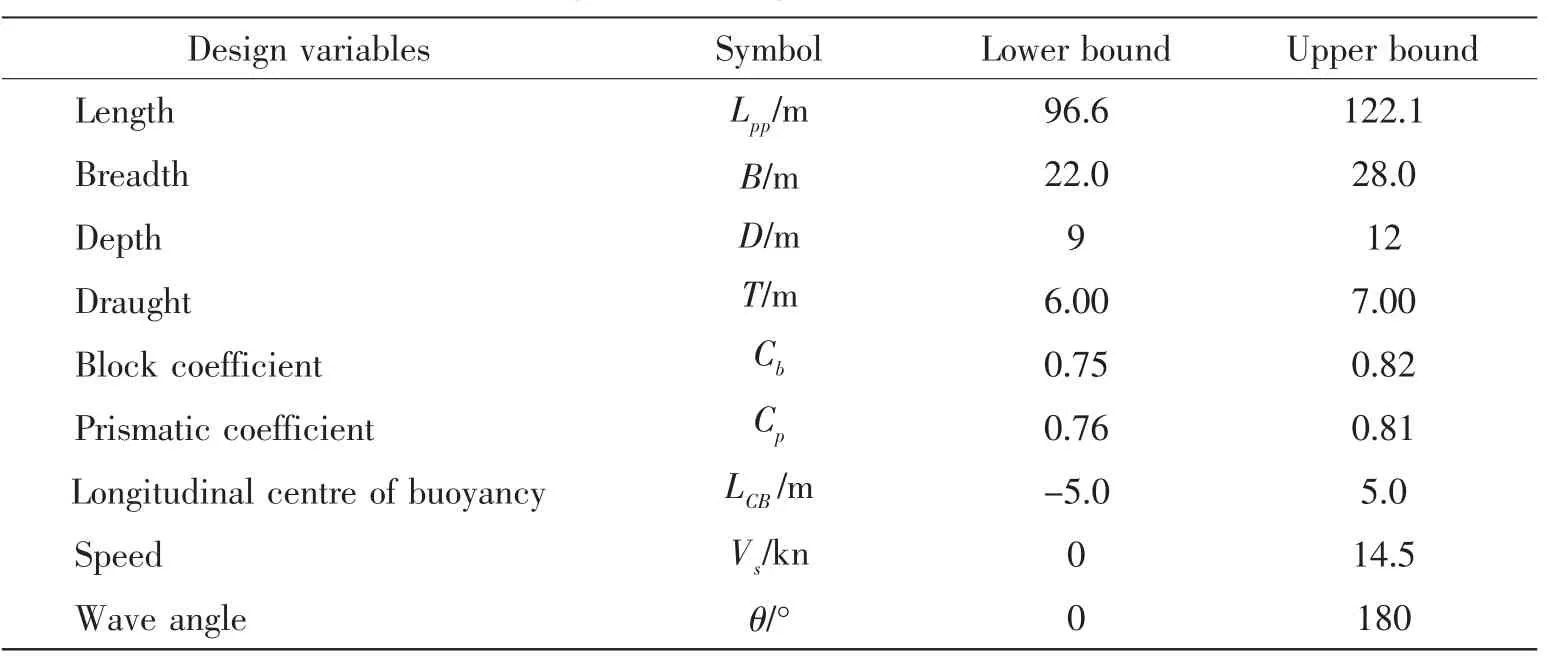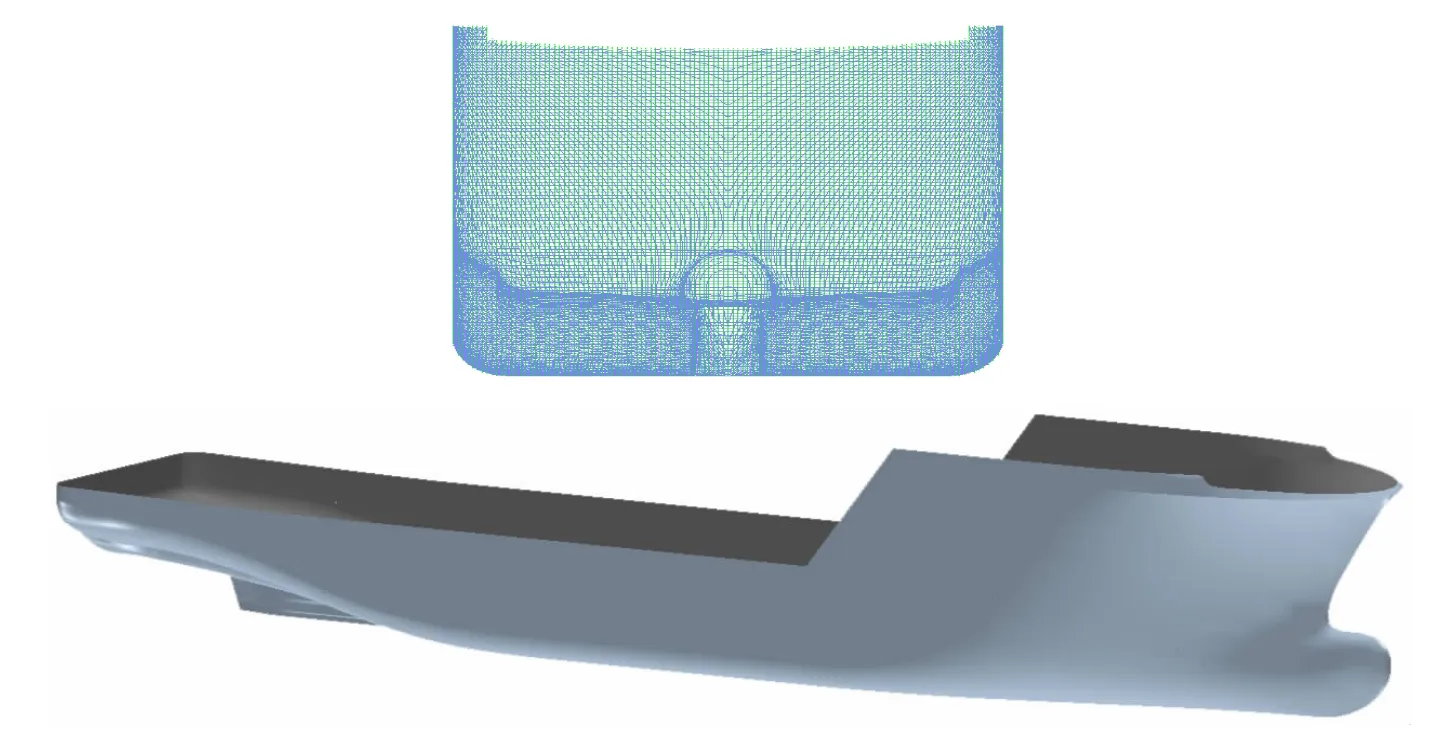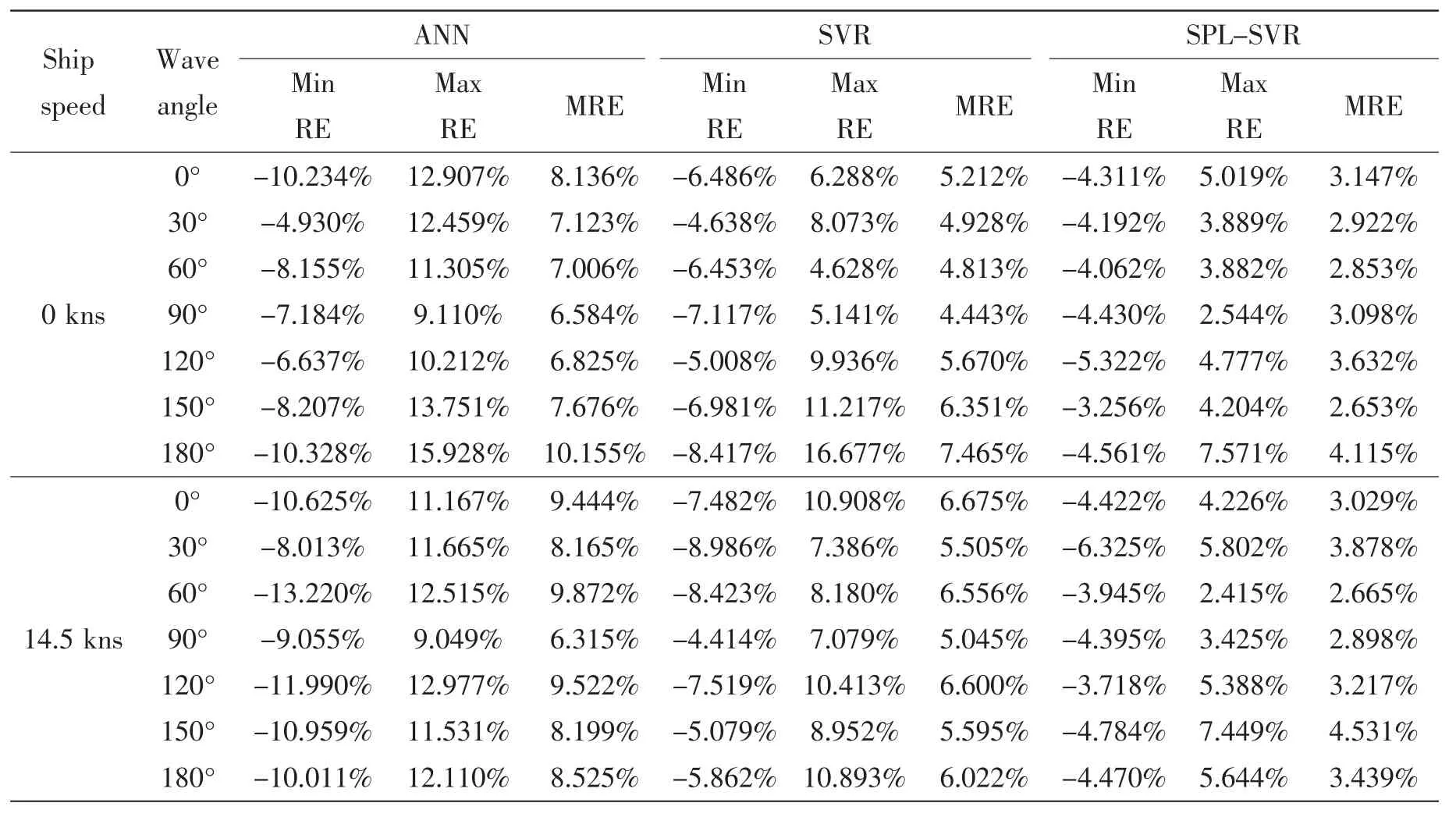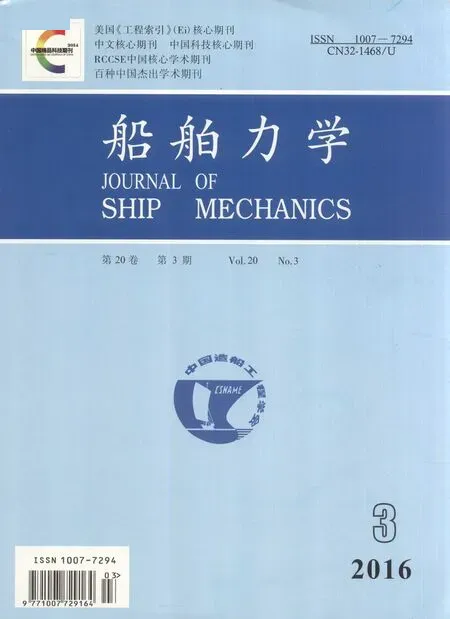Establishment of Metamodels for Ship Seakeeping Performance Using an Effective Approximation Modeling Method
,,,
(1.School of Naval Architecture&Ocean Engineering,Jiangsu University of Science and Technology,Zhengjiang 212003, China;2.Fluid Structure Interactions Research Group,Faculty of Engineering and the Environment,University of Southampton,Southampton,UK,SO17 1BJ)
Establishment of Metamodels for Ship Seakeeping Performance Using an Effective Approximation Modeling Method
LI Dong-qin1,Philip A.WILSON2,JIANG Zhi-yong1,ZHAO Xin1
(1.School of Naval Architecture&Ocean Engineering,Jiangsu University of Science and Technology,Zhengjiang 212003, China;2.Fluid Structure Interactions Research Group,Faculty of Engineering and the Environment,University of Southampton,Southampton,UK,SO17 1BJ)
The prediction of seakeeping performance for ships is a complex calculation process because of the large number of possible ship configuration variables that will affect the seakeeping motion; high fidelity commercial software is used to forecast the ship performance such as Computational Fluid Dynamics(CFD)then there is a large overhead in both time and money to use such software. In this paper,the Latin Hypercube Design methodology is employed to explore the design space and to sample data to cover the design space.An index is introduced,namely the percentage of downtime which illustrates the short-term and long-term ship seakeeping motion,defined as the comprehensive evaluation index for ship seakeeping performance,which is to be used in the comparison process of ship design.The five motions of ship seakeeping performance were considered as roll,pitch, yaw,sway and heave.To improve the efficiency of seakeeping calculation,an effective approximation modeling method-the Single-parameter Lagrangian Support Vector Regression(SPL-SVR)was adopted and trained to establish the metamodels and predict the seakeeping performance and this algorithm was first proposed by authors in their past studies.For the Offshore Supply Vessel(OSV), the seakeeping criteria were predicted with the SPL-SVR and compared with the NAPA-based calculation results with the seakeeping manager,the Artificial Neural Network results and classical SVR results.Using two ship speeds for an Offshore Supply Vessel,the metamodels of ship seakeeping performance of short-term percentage of downtime were established;these metamodels were suitable for the practical application in ship preliminary design stage and all the numerical results show the effectiveness of the new approximation algorithms.
metamodel;Support Vector Machine;design of experiment;seakeeping
0 Introduction
An accurate and effective prediction technique for the ship seakeeping performance plays an important role in the hydrodynamic-based ship design process.Specifically,it needs to en-sure two aspects.Firstly,a high-precision calculation method,i.e.,strip theory rather than empirical regression formula which has been widely used in ship seakeeping prediction[1],is required to calculate the ship motions in waves at the preliminary ship design stage.Secondly, and perhaps the most important part,is that the computational cost for seakeeping performance will be minimised.The authors have already performed initial research in the ship multidisciplinary design integrated with the ship resistance and ship seakeeping performance[2],the calculation seemed to be computationally expensive,time consuming and not of a great practical use.Although,the running speed of computers is now greatly enhanced,the cost of high precision computation for ship seakeeping performance in the preliminary stage is still too expensive and limits the progress of ship design.So far,the approximation model(metamodel or surrogate model)was adopted to solve this kind of problem in complex engineering system design and earned great progress[3].Referencing the same ideas,this paper makes an effort to improve a new simple and effective algorithm of Support Vector Machines and apply it to establish the metamodels of ship seakeeping performance.
1 Theoretical background of SPL-SVR
In real world design problems,there are often several disciplines in ship design.There are disciplines which may be studied with different software tools,or the disciplines may be searching for other solutions with different teams of engineers.With the increasing complexity of ship design problems,accuratly calculating ship performance has become increasingly difficult in the design process.Discovering a simple,accurate approximation model to replace the specific simulation calculation is the one way to satisfy the growing needs of computation.In the last century,researchers have successively proposed a variety of metamodeling techniques such as the neural network,the response surface method[4]and Kriging methods[5]to aid forecasting estimates for engineering computing needs.The use of metamodeling techniques to reduce the time spent on computational analyses is well known and will obviously increase the efficiency of the design process.
However,how do we improve the accuracy and robustness performance of metamodeling techniques is the really important question,especially when the sample size becomes small, limited and scarce and the established metamodels for ship performance will affect the final optimization solution.As a novel method of modern artificial intelligence technology,Support Vector Machines(SVM)[6-7]is proposed to aim at the limited samples problem and has a good generalization performance as well as global optimal extremum which have been proved by many researchers[8].
The SVM is based on Statistical Learning Theory(SLT),and has been recognized as a powerful machine learning technique.It offers a united framework for the limited-sample learning problem and can solve those practical problems such as model-choosing,limited samples, multiple dimensions,non-linear problems and local minima.By learning the training samples,it can obtain the black box which describes the complicated mapping relation without knowing the connection between the dependent variables and independent ones.Thus it has been used to construct metamodels and an excellent result has been achieved[9].
In this paper,we will use an effective approximation modelling method named Singleparameter Lagrangian Support Vector Regression(SPL-SVR),which is a new support vector regression algorithm proposed by the authors[10-11]to construct the implicit metamodels of ship resistance performance.It is worth mentioning that construction of metamodels of ship seakeeping performance in this paper is a continuation of the work in Ref.[10-11].These two references gave all details required.Here,we will briefly recall the mathematical theory of this algorithm for the readers’convenience.The methodology in short is given below:
In order to reduce complexity,the new algorithm of SVR has only one parameter ξ to control the errors instead of two parameters ξ,ξ*in the classical SVR,adds b2/2 to the item of confidence interval at the same time,and adopts the Laplace loss function.Hence we arrive at the formulation stated as follows:

The solution of Eq.(1)can be transformed into the dual optimization problem.A Lagrange function can be constructed and with the associated kernel functionwhich correspond to dot product in a feature space given by a nonlinear transformation φ of the data vectors in the input space.The Eq.(1)can be transferred into the dual optimization problem shown as follows:

Thus,the estimation function is calculated as follows:

In a sense,the complexity of a function’s representation by Support Vectors(SVs)only depends on the number of SVs.In this paper,we select a normal kernel function-the Radial Basis Function(RBF)[12].

2 Distributions of ship samples
To make the model simpler and computational feasible,some design parameters were fixed. At the same time,obtained from many shipping companies and design institutions,plenty of data about the offshore supply vessels were gathered.It was stipulated that the OSV would have two propellers and large block coefficient.The distributions of main principal characteristics are showed in Fig.1,in which the black round points represent the 30 training ship data from DOE method.

Fig.1 Distribution of vessels’principal characteristics
In fact,there are many variables which will affect the ship seakeeping performance.However,the addition of more variables to the model would hamper the result evaluation and the methodology validation.It could be that the performance criteria are based on ship wash and bow shape[13-15].Eventually,we chose the length between perpendiculars,the breadth,depth, the design draught,the block coefficient,the longitudinal prismatic coefficient,longitudinal centre of buoyancy,ship speed and wave angle as the design variables,and these nine parameters can show the geometrical characteristics of ship hull.Once the fixed parameters are established,the design variables are chosen and listed in the Tab.1.

Tab.1 Range of design variables in DOE
Here,we use the standard model-based calibration toolbox from commercial software Matlab to establish the training data set with Latin Hypercube Design proposed by Ref.[16].The training sample couples are taken from the DOE.A total of 30 ships were used in the test with the details listed in Tab.2 and one of the ship hulls is shown in Fig.2.

Fig.2 Transverse section and 3D lay-out of the ship hull

Tab.2 Design variables of selected 30 training ship data

Continue Tab.2
3 Calculation of ship seakeeping performance
Before establishing the metamodels of seakeeping performance and its effects in the ship design process,we should first decide which calculation method for the ship seakeeping performance of offshore supply vessel should be used.
3.1 The actual wave conditions
It is important to realize that the wave spectra are attempts to describe the ocean wave spectra in very special conditions,namely the conditions after a wind with constant velocity has been blowing for a long time.A typical ocean wave spectrum will be much more complicated and variable.Here,the JONSWAP spectrum for North Sea and South Sea of China is capable of giving the safe analysis results of ship motions in wave.
The JONSWAP spectrum is a Pierson-Moskowitz spectrum multiplied by an extra peak enhancement factor and is used to represent a fetch limited sea spectrum as for the two sea areas previous mentioned.

3.2 Wave scatter table in South Sea of China
Considering the actual wave influence in design,we often need to know the maximum of wave parameters which will happen over a period of several years.In order to establish longterm forecasts,we also need to know the joint probability distribution of the significant wave height and average zero crossing period,usually expressed by the use of the wave scatter table. The wave information in South Sea of China was collected in Ref.[17],where the area ranges is 105°-125°east longitude,0.5°-23°north latitude.
Actually,based on the need of ship performance prediction and ship hull design,muchmore emphasis should be laid on the collection of basic environmental information about the wind,wave and current in navigation area.The wave scatter table in South Sea of China is listed as Tab.3.

Tab.3 Wave scatter table in South Sea of China(Annual)
3.3 Determination of seakeeping criteria
The limitation of the ship motion was estimated from data gleaned from OSV operators and the weight for seakeeping criteria in different condition are given in Tab.4.The velocity of 0 kn is the normal working condition,and the velocity of 14.5 kns is the normal operating speed for the vessel from harbor to working area for the OSV.

Tab.4 Seakeeping criteria values or allowed probabilities for OSV
3.4 Comprehensive evaluation index for seakeeping performance
There are many factors influencing the ship seakeeping performance especially for different types of deep-sea vessels,it is difficult to decide the optimum design with good seakeeping performance according to one or more basic seakeeping factors.It is necessary to find a proper comprehensive evaluation index for ship seakeeping performance.There are now two types of evaluation index:one is the percentage of working time,the other is the percentage of desired speed.Here,we propose a new index of long term forecast percentage of downtime, which aims to show the ability of ship working in the prescribed conditions(environment andtime)and is an effective evaluation index of seakeeping quality.Specific calculation steps are listed as follows:
Step 1:According to the working requirement,choose the navigation speed and working speed of OSV.Calculate the frequency response functions in regular wave under specific velocities Vsand wave angles μm.
Step 2:Choose the ocean wave spectrum,predict the ship motion responses and accelerations of the unit significant wave height under the irregular wave.
Step 3:Gather the ocean wave statistics information around the ship working area,the actual ocean wave environmental condition and wave statistics probability(Scatter Diagrams),determine the various seakeeping criteria factors k and establish the seakeeping criteria group Ck.
Step 4:Calculate motion response RAO ra()1/3for various seakeeping criteria factors under the specific speed Vs,wave angles μmand different wave period Tjin the irregular wave. Then calculate the limited wave height Hsmjkand the percentage of downtime POTsmkfor different seakeeping criteria factors k under the specific speed Vsand wave angles μm.
Step 5:Based on the importance distribution αk(or weight coefficient)of each seakeeping criteria factor k in the seakeeping criteria group Ck,calculate the comprehensive evaluation index POTshortfor seakeeping performance which is called the ship short-term percentage of downtime and this index indicate the ultimate working capacity of ship under the given speed and wave angle.

Step 6:Considering the speed frequency distributionand wave angle frequency distributionin the real voyage,the comprehensive evaluation index POTlongfor seakeeping performance which is called the ship long-term percentage of downtime can be calculated as below:

4 Establishment of ship seakeeping metamodel
Hydrodynamic design of ships involves several stages,from preliminary and early-stage design to late-stage and final design.As the objective of this study is to develop a practical metamodel of an offshore supply vessel at the early stage of the hydrodynamic-based ship design,a practical calculation tool,based on the strip theory called Seakeeping Manager from the commercial software NAPA,is used to compute the ship motion in irregular wave including roll, pitch,yaw,sway and heave motions.

Fig.3 Response functions for the seakeeping criterias(Vs=0 kns)
Firstly,we consider that the working speed for the offshore supply vessel is 0 kns and navigation speed is 14.5 kns,and the wave angles are 0°,30°,60°,90°,120°,150°and 180°. We choose one of the 30 ship training data above to calculate the seakeeping performance as an example.As mentioned above,we choose seven seakeeping criteria to evaluate the ship seakeeping performance:roll,pitch,slam,heave,propeller emergence,deck wetness and vertical acceleration at bow.Further,some of the response functions of these seakeeping criteria under different wave angles are shown as Fig.3.
Considering the wave scatter table in South Sea of China,the percentage of downtime (which means non-working time)is shown in Fig.4 which indicates the comprehensive evaluation index for the seakeeping criteria will meet the permission of design requirements.
Further,the benchmarking methodology presented here can be used in a wider setting to analyze how the performance is affected by certain design decisions.Hence,this approach can support the design process with performance estimated at an early stage,without running expensive model tests or time consuming CFD calculations.Here,we construct the metamodels of ship seakeeping performance based on the theory of Support Vector Machine and set up the program in Matlab.


Fig.5 Approximation results of downtime POTshortfor ship type 20 to 30(Vs=0 kns)

Fig.6 Approximation results of downtime POTshortfor ship type 20 to 30(Vs=14.5 kns)
Here,the first 20 ship types created with the DOE method are selected as training data set and the last 10 ship types as test data set.The chosen variables are the length between perpendiculars,the breadth,depth,the design draught,the block coefficient,the longitudinal prismatic coefficient,longitudinal centre of buoyancy,ship speed and wave angle as the design variables,and the ship short-term percentage of downtime POTshortbased on the importance distribution weight for seven seakeeping criteria under the circumstance of the working speed and navigation speed as the output variable.The calculation results with velocity 0 kns and 14.5 kns were compared with Seakeeping Manager,ANN and classic SVR which were shown as Fig.5 and Fig.6.
Here,the calculated results for the working speed with wave angle 60°and navigation speed with wave angle 120°are listed in Tab.5 and Tab.6.The Relative Error(RE)and Mean Relative Error(MRE)are applied as performance indexes:


Tab.5 Calculation results with Relative Error(RE)for downtime POTshortwith wave angle 60°(Vs=0 kns)

Tab.6 Calculation results with Relative Error(RE)for downtime POTshortwith wave angle 120°(Vs=14.5 kns)

Continue Tab.6
The comparison of relative errors for different wave angles and velocities is listed in Tab. 7.The maximum MRE within the different wave angles and velocities comparing to the result of seakeeping Manager for ANN is 10.155%and the minimum MRE is 6.315%;the maximum MRE for SVR is 7.465%and the minimum MRE is 4.443%;the maximum MRE for SPL-SVR is 4.531%and the minimum MRE is 2.653%.It can be seen that the results are acceptable and agree well with each other.Obviously,if the training ships data set,the kernel parameters and the calculation method for seakeeping criteria are chosen properly,we can use these metamodels to predict the ship seakeeping performance in the preliminary ship design stage.

Tab.7 Comparison of downtime errors POTshortfor the two ship speed(Unit:%)
Considering the two kinds of circumstances,the proposed SPL-SVR algorithm shows a good approximation and prediction performance,so we can also find that this new algorithm of Support Vector Machine is suitable for the nonlinear approximation problem whether in the running time or accuracy.Obviously,we can obtain high fitting precision calculation results for seakeeping performance in the CFD-based preliminary ship design process.That is to say,we can use these metamodels to calculate the ship short-term seakeeping performance POTshortinstead of CFD method in the preliminary ship design stage.Considering the ship speeds and wave angle frequency distributions in the real voyage,the comprehensive evaluation index POT for long-term seakeeping performance can be also evaluated.
5 Conclusions
In this paper,a new SVR-based algorithm was proposed and used to establish metamodels for predicting the ship seakeeping performance of Offshore Supply Vessel.Comparing to ANN and classic SVR,the proposed SPL-SVR can achieve the most accurate calculation results.In the meantime,these metamodels were also quite precise compared to the expensive simulation tool for the complete analysis and calculation of ship seakeeping performance together with dramatic reductions in processing time at preliminary design stages.In order to train this new algorithm,the RBF kernel function was adopted and its parameters should be considered carefully.This indicates that the SPL-SVR-based metamodels can be used to evaluate the ship seakeeping performance accurately and less time-consuming at the preliminary design of offshore supply vessel.
Further developments using this techniques are currently being considered include the use of SPL-SVR to establish the surrogate models of ship resistance and manoeuvring performance,and the integration of three kinds of surrogate models with multidisciplinary design optimization in the preliminary design of offshore supply vessel.Under these circumstances the development of MDO frameworks for Offshore Supply Vessel which combines these less costly analysis metamodels with global optimization algorithms will be successful.
Acknowledgments
The authors wish to thank The National Natural Science Foundation of China(Grant No. 51509114),The Natural Science Foundation of Jiangsu Province of China(Grant No.BK2012-696)and the Project funded by the Priority Academic Program Development of Jiangsu Higher Education Institutions(PAPD)for their financial support.
[1]Ôzüm S,■ener B,Yilmaz H.A parametric study on seakeeping assessment of fast ships in conceptual design stage[J].O-cean Engineering,2011,38(13):1439-1447.
[2]Li Dongqin,Jiang Zhiyong,Yang Yongxiang.Multidisciplinary and multi-objective design optimization based on adaptive weighted-sum method[J].Shipbuilding of China,2012,53(4):75-83.
[3]Leifsson L,Koziel S.Multi-fidelity design optimization of transonic airfoils using physics-based surrogate modeling and shape-preserving response prediction[J].Journal of Computational Science,2010,1(2):98-106.
[4]Balabanov O.Development of approximations for HSCT wing bending material weight using response surface methodology [D].Dissertation Virginia Polytechnic Institute and State University,Blacksburg(VA),1997.
[5]Zhang Guanyu,Wang Guoqiang,Li Xuefei,Ren Yunpeng.Global optimization of reliability design for large ball mill gear transmission based on the Kriging model and genetic algorithm[J].Mechanism and Machine Theory,2013,69:321-336.
[6]Vapnik V N.The nature of statistical learning theory[M].New York:Springer-Verlag,1995.
[7]Smola A J,Schölkopf B.A tutorial on support vector regression[J].Statistics and Computing,2004,14:199-222.
[8]Vapnik V N.Universal learning technology:Support Vector Machines[J].NEC Journal of Advanced Technology,2005,2 (2):137-144.
[9]Yun Yeboon,Yoon Min,Nakayama H.Multi-objective optimization based on meta-modeling by using support vector regression[J].Optimization Engineer,2009,10:167-181.
[10]Li Dongqin,Guan Yifeng,Wang Qingfeng,Chen Zhitong.Support vector regression-based multidisciplinary design optimization for ship design[C]//Proceedings of the 31th International Conference on Ocean,Offshore and Arctic Engineering,June 10-15,2012.Rio de Janeiro,Brazil,2012.
[11]Li Dongqin,Philip A.Wilson,Guan Yifeng,Zhao Xin.An effective approximation modeling method for ship resistance in multidisciplinary ship design optimization[C]//Proceedings of the 33th International Conference on Ocean,Offshore and Arctic Engineering,June 8-13,2014.San Francisco,California,USA,2014.
[12]Liu Zhiliang,Zuo Ming J,Xu Hongbing.Parameter selection for Gaussian radial basis function in support vector machine classification[C].Proceedings of 2012 International Conference on Quality,Reliability,Risk,Maintenance,and Safety Engineering,2012:576-581.
[13]Doyle R,Whittaker T J T,Elasaber B.A study of fast ferry wash in shallow water[C]//FAST 2001.Southampton,2001: 90-96.
[14]Doctors L J,Phillips S J,Day A.Focussing the wave-wash system of a high speed marine ferry[C]//FAST 2001.Southampton,2001:97-106,.
[15]Keuning J A,Pinkster J.The effect of bow shape on the seakeeping performance of a fast monohull[C]//FAST 2001. Southampton,2001:197-212.
[16]McKay M D,Conover W J,Beckman R J.A comparison of three methods for selecting values of input variables in the analysis of output from a computer code[J].Technometrics,1979,21(2):34-42.
[17]Hogben N,Dacunha N,Oliver G.Global wave statistics[M].British Maritime Technology,1986.
Philip A.WILSON(1954-),男,英国南安普顿大学流体结构耦合研究小组教授;
蒋志勇(1956-),男,江苏科技大学船舶与海洋工程学院教授;
赵 欣(1990-),女,江苏科技大学船舶与海洋工程学院硕士生。
一种有效近似建模方法及船舶耐波性代理模型构建
李冬琴1,Philip A.WILSON2,蒋志勇1,赵 欣1
(1.江苏科技大学 船舶与海洋工程学院,江苏镇江212003;2.南安普顿大学 工程与环境学院,流体结构耦合研究组,英国南安普顿 SO17 1BJ)
船舶耐波性能预报计算过程复杂,会受到诸多设计变量的影响;且采用高精度商业软件如CFD预报船舶性能的计算代价非常高。文章采用拉丁超立方方法进行了设计空间抽样。定义了一个新的综合衡准指标来表达船舶耐波性能,即短期和长期作用下船舶非工作时间百分数。考虑了船舶耐波性能中的五个运动方向:横摇、纵摇、转艏、横荡和升沉。为提高船舶耐波性能计算效率,一种有效的近似建模方法—单参数Lagrangian支持向量回归算法被用于训练并构建代理模型以预报船舶耐波性能,且该算法是由作者在过去的研究工作中首次提出。以海洋平台支援船(OSV)为例,采用SPL-SVR算法预报船舶耐波性能,并与基于NAPA计算仿真结果、人工神经网络和经典支持向量回归算法进行对比。该文考虑OSV的两种速度,建立了海洋平台支援船短期作用下非工作时间百分数的耐波性能响应面模型,结果显示采用SPL-SVR算法建立的船舶耐波性能响应面模型比较适合船型初步设计的工程实际应用,并具有较高的计算效率。
代理模型;支持向量机;实验设计;船舶耐波性
U661.73
:A
李冬琴(1979-),女,江苏科技大学船舶与海洋工程学院副教授;
U661.32
:A
10.3969/j.issn.1007-7294.2016.03.002
1007-7294(2016)03-0243-15
Received date:2015-08-20
Foundation item:Supported by the Natural Science Foundation of Jiangsu Province of China(Grant No.BK2012696); the Priority Academic Program Development of Jiangsu Higher Education Institutions(PAPD)
Biography:LI Dong-qin(1979-),female,associate professor,E-mail:mandy_ldq@163.com; Philip A.WILSON(1954-),male,professor.
- 船舶力学的其它文章
- Numerical Predictions of the Propeller Cavitation behind Ship and Comparison with Experiment
- Influence of Added Wave Resistance Calculation Methods on Ship Speed in Seas
- A Comparison of Positioning Capabilities between Vessels with Different Thruster Configurations
- Numerical and Experimental Investigation of the Problem of Diving Difficulty of Autonomous Underwater Vehicle
- Numerical Prediction and Experimental Measurement on Truss Spar Motion and Mooring Tension in Regular Waves
- A Combination Mooring System and Mooring Characteristics Study

